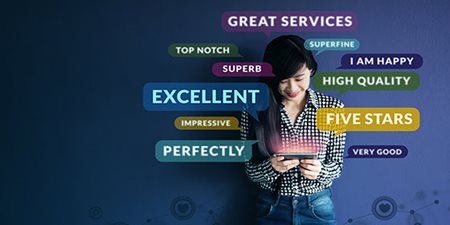No Pressure but CX Could Make or Break Your Brand
By Gabriella Pirrone
September 3, 2019
Crownpeak, customer experience, Customer Service, CX, Elastic Path, Lithium, omnichannel, Rightpoint, SAP, sitecore, Spredfast
*Originally published January 25, 2019
It seems that a shared goal amongst brands is to offer up a great customer experience that will be reciprocated by recurring customers who engage/buy more, build loyalty, and share their positive interactions with their peers. But there’s also a large disconnect. According to a study conducted by PwC, bad experiences are driving customers away—and fast. “One in three consumers (32%) say they will walk away from a brand they love after just one bad experience. This figure is even higher in Latin America, at 49%.”

It's really a no-brainer that creating meaningful experiences and connecting with your customer can also prevent this from happening: “People are not willing to watch or consume a 30-second ad if they have no connection with the brand.”, warns Thales Teixeira, Harvard Business School Professor. Take Nike for example: “Since the launch of Nike+, Nike has continued to develop online experiences that enhance their customers’ offline interaction with the brand and its products. By developing applications and content that track customers’ physical activity in real time, enabling them to connect with others and providing them access to content and other experience-enhancing activities, it has successfully delivered on a seamless experience that builds loyalty and increases athletes' engagement with their brand.”, stated Bryan Finke, VP Communications & Customer Experience Strategies at Yes Marketing in a recent exclusive interview.
Along with my thoughts on customer experience and the biggest takeaways, I will also share exclusive commentary from industry experts that we were fortunate enough to gather in 2018. It will touch on the three areas that are most important to consider when it comes to strategizing a great customer experience that could make your brand, and how to avoid the disconnects customers are feeling that could break your brand.
Focus on Your Approach
In order to create an exceptional customer experience, you need to be able to personalize those experiences. To do so, brands need to be able to quickly adapt to change at any given time and not have to rely on IT staff. For example, look at the technology that you’re using and strategize on the ways to adapt and adjust to your customers’ needs and the different ways to connect as new technologies evolve as illustrated below.
“Brands today need the ability to deeply personalize customer experiences, adapt quickly to changing market needs, and eliminate the need to involve IT staff in every adjustment to the customer experience. Utilizing open source content management along with headless commerce, brands can create personalized commerce experiences at any and every touchpoint imaginable and know their brand feels the same to each customer, at every point. Customers will be greeted with a content-rich, personalized experience -- much beyond remembering names, birthdays and purchase history -- and will be consistent across any touchpoint, whether in-store, online, a voice-enabled car screen, to IoT devices, to AR/VR and much more.”—Darin Archer, CMO at Elastic Path
“When there is a disjointed customer experience with a business, there is a lost competitive advantage. IT and marketing must align to solve this challenge and leverage the right technology and a digital strategy that prioritizes a customer-centric approach, including personalized experiences and a trusted customer relationship,”—Anil Gupta, Executive Vice President of Program Management at Sitecore
Omnichannel Should Be Top of Mind
Being able to interact with a brand and consistently receive the same experience throughout the journey is sometimes hard to find unless the brand is Starbucks, who many consider to have one of the top omnichannel experiences out there—and if you don’t know about it, you should. However, even though I could talk all day about great omnichannel experiences, there are many consumers who hold the opposite notion, unfortunately. According to Kamplye, “87% of customers think brands need to put more effort into providing a consistent experience.” Many consumers have a different experience across different channels. Take mobile for example. My colleague Laura and I share the same sentiment about Starbucks when it comes to their mobile strategy and using mobile to support the customer experience. “Starbucks was able to disrupt the tired point of sale model to allow customers to begin their purchase experience on their mobile device, finishing with a much more streamlined acquisition of their daily dose of caffeine.” Below, you’ll read more on omnichannel experiences that are good to keep in mind.
“Seamless, satisfying, and personalized experiences across any channel is what today’s consumers want and expect, regardless of industry. Yet, our research found that 58% of consumers have been forced to move to a different channel when making a customer service request (e.g. they start an online chat and then are forced to call into a customer service rep). 49% were left feeling less positive about the brand as a result, with 30% considering taking their business elsewhere. One key area the financial marketplace needs to zero in on is owning the customer experience in order to protect data, comply with regulations, and provide the seamless personalized experience."—Katherine Calvert, CMO at Spredfast + Lithium
“There is a significant gap in what consumers are seeing throughout their online shopping journey, and shoppers are not seeing product recommendations that fit their individual needs. In the age of omnichannel shopping, consumers expect brands to understand their entire history regardless of channel, which is something many brands continue to have challenges with—primarily because of data silos. These gaps can contribute to missed market opportunities.
Companies need to begin by shifting their mindset to address the overall need for an end-to-end unified process that accounts for every stage of the customer journey. Moreover, accurate data enables new customer experiences economy—but only if handled with care. Businesses have an imperative to gain trust and build an emotional and personal relationship with each customer. However, this is only possible if consent is present. In addition to bridging data-silos and harnessing accurate customer data, brands must ensure that their supply and demand pieces of the customer journey are integrated, so that customers no longer view suggestions for purchases that have already been made, are kept apprised of any out-of-stocks, or are looped in on any other factors that might impact their customer experience."—Chris Hauca, Head of Strategy & GTM SAP Commerce Cloud
“Omnichannel started out as the right way of approaching the customer experience 5–6 years ago, when you had multiple channels you sold through you wanted to make sure whatever content you were producing wasn’t out of brand or out of context, to what the buyer was doing if they moved to different kinds of channels.”—Dale Traxler, VP Commerce Solutions at Rightpoint
Stay Connected to Your Customers
With the vast amount of channels available, being able to stay connected to your customers has grown exponentially. Back in the day, you were able to call, fax, or email. Now you have access to popular social channels like Twitter, Facebook, Instagram, etc., that allows your customers to connect with you in a much faster and convenient way. Use these channels to create connections and easily communicate with your customers. Below, you’ll see a collection of thought leadership on more ways to create customer connections.
“Customers can say 'no' now. So we as brands—as enterprises—we have to find ways to get them to say 'yes', and so that's an earning-the-right kind of moment, and I think customer experience is going to evolve into 'how do I earn that right'? What do I do that's good for you as a customer that will earn the right for you to say 'yes'?"—Darren Guarnaccia, Chief Product Officer at Crownpeak
“We live in a world where everything and everyone is connected. Brands should approach improving their customer experience from this same standpoint. It’s essential to apply that to all aspects of the business—sales, service, commerce, marketing and customer data management—into one single view. This is the only way to truly understand customer behavior and intent. It also allows companies to be more transparent when it comes to practices around how they handle customer data. By placing transparency and trust as top priorities, brands will build a rapport with customers and in turn facilitate memorable and positive experiences.
The customer is what can make (or break) a company, which is why companies of all industries and sizes are eager to understand their customers to give them the best possible experience to differentiate themselves from the competition and to stay successful. Brands need to prioritize using the proper digital touchpoints and respective tools, in order to fully engage with customers directly, creating a positive experience.“—Moritz Zimmermann, CTO SAP Customer Experience
“Again, almost the simplification to the customer experience. Can I take friction out of your experience? Can I do things that you want? Can I help you achieve your jobs to be done as a customer in a way that is less friction, higher value? And ultimately, it's about doing what's right by the customer to earn trust. All of those things is the big shift, and if voice helps us with that, great! If AI helps us with that, awesome! But I don’t think it's about the technology. I think it's about, you know, solving the customer problem and what they're trying to do."—Darren Guarnaccia, Chief Product Officer at Crownpeak

Gabriella Pirrone
Gabriella is the Digital Marketing Assistant for CMSC Media. She brings a wealth of knowledge from not only a CMS perspective but also content, SEO and eCommerce. She enjoys everything social media and staying ontop of the latest trends in the digital marketing world.